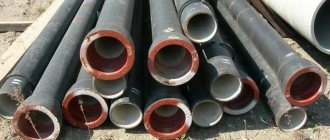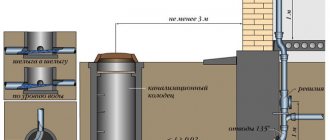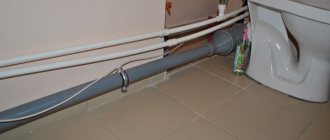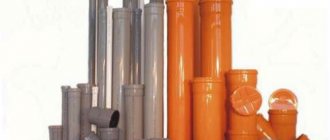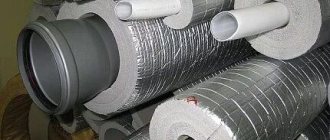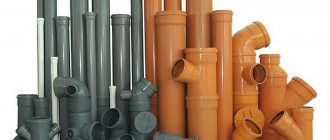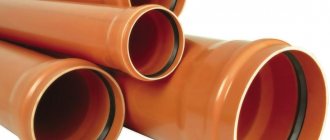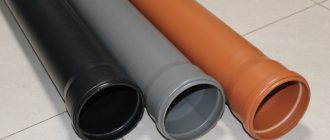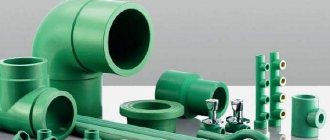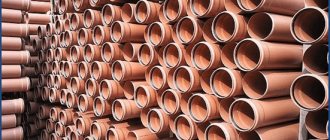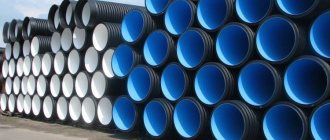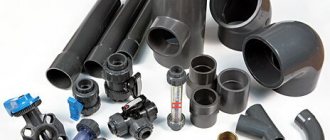Are you concerned about the arrangement of internal communications and the drainage system outside the house? Agree, it’s great when a country house has all the benefits of civilization, despite its remoteness from the metropolis.
But to build a system, you need sewer pipes for external sewerage, and you don’t know which ones are best to choose?
We will tell you which material is suitable for various operating conditions - the article discusses the characteristics of pipes made from existing materials, the advantages and disadvantages of each option.
There is also a rating of the best manufacturers of plastic and cast iron pipelines, selected photographs depicting their products and video recommendations from sewerage professionals.
Differences between external and internal sewage systems
The pipes that are used for laying external systems differ significantly from the analogues used for internal communications.
Detailed information about pipes for internal sewerage is discussed in this article.
External sewer systems differ from internal pipes in their bright orange color, as well as increased density and wall thickness.
Characteristic features include:
- Color . Orange (red) color, which makes the pipe easy to locate, therefore avoiding unintentional damage to the network during excavation work.
- Wall thickness . For parts for external sewerage, this parameter is always higher than for internal sewerage (when using PVC systems, these figures are 3.2-3.4 mm versus 2 mm), since the pipeline laid underground has to withstand heavy loads.
- Materials . Red pipes are usually made from materials of increased resistance (for example, unplasticized polyvinyl chloride, which is particularly durable).
- Heat resistance . Thanks to the increased thickness and reliability of the walls, as well as the addition of specially selected components, the heat resistance of external systems is higher than that of internal ones. But they may also need insulation. We recommend that you familiarize yourself with the types of insulation for sewerage.
- Life time . Orange-colored products tend to last longer than gray ones.
- Price tag . The cost of elements for external sewerage is approximately 20% higher than for internal sewerage.
Experts warn against using gray pipes for laying external sewerage systems. It is difficult for them to withstand increased load (especially for a long time), which can lead to breakthroughs and accidents.
Let's take a closer look at what materials can be used for the manufacture of external sewer systems.
Summarizing
There is another type of material for the construction of sewer systems - ceramics. The popularity of this material is due to the special structure of the inner surface, which categorically excludes the possibility of the formation of stagnation and plaque. However, it is rarely used in individual installations of external sewer systems, since it is more expensive and also requires a large number of connectors, since the length of solid pipes is no more than 2-3 meters.
Based on the above, the optimal solution for independently installing an external sewer system in a private house is plastic products, despite their low strength indicators. To increase the reliability of the structure, it is recommended to use corrugated two-layer pipelines.
The best sewer pipe manufacturers
Many foreign and domestic companies produce pipes made of various materials used for laying external sewers.
Place #1 - Dutch plastic manufacturer Wavin
The Wavin company, founded in Holland in 1955, specializes in the production of sewer and water plastic pipes. The company's products are in great demand throughout Europe.
The Dutch company Wavin is well known in European countries. The company offers a wide range of pipes and fittings for external sewerage
For outdoor use, the manufacturer produces Pragma corrugated polypropylene pipes, which have double walls, as well as other product options.
The Pragma components are 6 meters long; they are easily connected into a system, since they have a socket at one end and a rubber seal at the other. The manufacturer recommends using these products to create a network of external gravity sewerage.
Place #2 - international company POLIPLASTIC
POLYPLASTIC is an international company, whose divisions are located in the CIS countries (Russia, Kazakhstan, Belarus).
Among the range of branded products, a large place is occupied by all kinds of sewer elements, including external pipes made of various types of polymers (polyethylene, PAC, polypropylene, fiberglass).
The products produced by the company are characterized by an optimal combination of low weight with increased ring rigidity, due to which plastic pipes successfully resist even significant loads.
Reinforced products "Corsis Arm", included in the range of the POLIPLASTIC company, have a steel layer that enhances the rigidity of external sewer pipes
The signature line of this manufacturer is the Korsis series, which includes:
- two-layer corrugated products;
- spiral parts;
- multilayer reinforced pipes.
All these elements are perfect for laying external sewer networks and other drainage systems. The company produces products with a length of 600 or 1200 mm, a diameter of 110-600 mm.
Unlike other products, they have a corrugated black outer layer and an inner surface of light blue, yellow or orange.
Place #3 - German company Ostendorf
The famous German company Ostendorf Kunststoffe, which specializes in polymer pipes and other parts, was founded by the Ostendorf brothers in 1973.
Now the company is considered a leading manufacturer of elements of such systems in the specialized market. Products are supplied to many countries around the world, but the main consumer is Germany.
KG pipes (manufactured by the German company Ostendorf) have high consumer qualities. Such systems are durable, reliable, durable, and easy to operate.
In 2011, the Ostendorf plant began operating in Russia. The enterprise, where the latest technological equipment manufactured in Germany is installed, uses imported raw materials and components.
Strict quality control is organized in production, which is carried out in accordance with German and Russian standards.
Due to the highest quality of products, they are in high demand among consumers, despite their relative high cost.
The KG line, intended for external sewerage, is made of solid polyvinyl chloride without impurities, which has increased strength, water resistance, durability, and thermal conductivity.
The convenient shape of the ends allows for quick and easy installation of various systems.
Place #4 - domestic company Politek
Russian, founded in 1999, is a leader in the production of polymer products used for drainage, water supply, and sewerage.
The products of the domestic company Politek have gained popularity due to the optimal ratio of quality and price. Even budget products have decent characteristics
The company's factories have installed the latest foreign special equipment, which allows them to produce European-class products.
Place #5 - German cast iron manufacturer Duker
Although metal products are now less common than plastic ones, the demand for cast iron pipes can be called stable. Such products are produced by several European companies, among which the following can be noted.
Founded in 1913 in Karlstadt (Franconia, Germany), the company initially produced products with socket systems.
In 1968, innovative socketless pipes were developed, allowing parts to be shortened and the remaining trim to be installed using a combination method.
Now the company is the only manufacturer of cast iron sewer systems in Germany, and the plant carries out a completely completed production cycle: from casting to applying external coating.
The company offers a wide range of different systems with different lengths, diameters and connections. All of them have excellent consumer qualities: wear resistance, resistance to aggressive substances, strength.
Duker cast iron pipes are wear-resistant and their quality is excellent. In addition, thanks to the wide range, you can easily select pipes of the desired diameter
Place #6 - French company Saint-Gobain
The large concern Saint-Gobain (France) specializes in the production of modern cast iron products. For their manufacture, De Lavo technology (centrifugal casting) is used, followed by deep cooling of the structures.
Cast iron pipes, called Pam Global, are produced at the factories of a large French concern. During the production of products, the metal is coated with epoxy resin, zinc powder and acrylic varnish
Pam Global C systems are specifically designed for ground work, as well as the installation of high-quality, durable drainage systems. External sewer pipes have a diameter of 100-200 mm.
Characteristics
One of the features of PVC pipes is the difference in their diameter. Pipe diameter is the main characteristic that is taken into account when installing internal or external sewerage. Risers with a caliber of 75 mm are convenient for work. To remove sewage, equipment with a diameter of 100 mm is used, and industrial facilities are cleaned by installing risers with a caliber of 300 mm. To service networks of large residential buildings, equipment with a diameter of 250 mm is used.
Scheme of laying sewer pipes.
The most important criterion when choosing a material is its density, which is 1.35-1.43 per 1 cm³. Sewage equipment melts at temperatures above 120˚C. The material conducts electricity poorly, has elasticity, and is resistant to alkalis and acids.
During installation, you should take into account the fact that any irregularities inside the shortened pipe contribute to its clogging with garbage and household waste. The minimum operating pressure in the network after its installation should not exceed 0.16 MPa.
Impact resistance is 10% and is determined by the depth of the cracks. The relative removal of networks upon rupture is 25%, their softening temperature does not exceed 80˚C, and the tensile yield strength is 44.1 MPa. A pipe with a caliber of 160 mm is used for installing a non-pressure network. The length of the riser is from 1 to 3 m, and the laying depth is 5 m.
When choosing pipes for installation of a sewage treatment and transportation system, they are guided by the current standards governing production. The plastic pipe is manufactured in accordance with the requirements of GOST 26996-86, which indicate the composition of polypropylene. Unfortunately, plastic is much worse than cast iron at absorbing acoustic waves and preventing vibration. The main reason for this phenomenon is that the material is very light and thin.
The thermal conductivity of PVC products corresponds to similar indicators of insulating materials.
Conclusions and useful video on the topic
Below we offer a video that gives recommendations on choosing pipes for internal and external sewerage.
It is impossible to say unequivocally which type of pipe is the best. When considering product options, it is important to know for what purpose they are intended and under what conditions they will be used .
Only taking into account all the individual characteristics of the site, the owner can make a choice which option is best for him for arranging a sewer system.
Are you selecting pipes for sewer installation and still have questions after reading the article? Or did you notice errors or inaccuracies in the material reviewed? Please write to us about this in the comments below the article.
Or maybe you have already chosen the material and installed the sewer pipeline on the site? Tell us what type of pipes you preferred and how comfortable it was for you to work with them.
Operational Features
Today, sewer pipes for external sewerage made of uPVC are actively “penetrating” into all spheres of economic activity, replacing concrete, steel, and cast iron.
Advantages of uPVC pipes for external sewerage
- Resistance to corrosion, formation of oxides, films, overgrowing of the working clearance.
- No cathodic protection required.
- Resistance to aggressive environments, including acids, alkalis, abrasives.
- Stable throughput until the end of its service life.
- Less weight compared to cast iron and steel.
- Estimated service life 50 years (no longer estimable due to recent use).
- Reduced costs for loading, unloading and delivery.
- Easy installation without the use of heavy equipment.
- Lighter requirements for installation personnel.
- Availability for networks of any purpose and complexity.
- Adaptability when connecting to equipment due to a wide range of shaped products.
- Hygienic and environmentally friendly - in a stable state they do not emit harmful substances and do not form rotting products.
- Not subject to deformation at low temperatures.
Disadvantages of uPVC pipes
- Small operating temperature range (from -5 to -600C for most brands)
- Susceptibility to damage by rodents.
- Release of toxins when melted.
There are significantly fewer disadvantages, which makes this option attractive. With a little skill, an external PVC pipe can be installed independently on a small scale.
What can you choose from?
There are quite a lot of pipes suitable for arranging external sewer pipelines. If desired, you can even make it from glass parts. However, this is rather exotic. Let's look at the most popular options among developers.
Option #1 - asbestos cement parts
A mixture of asbestos fiber and Portland cement is used to produce products. The advantages of such pipes are:
- Durability. An asbestos cement system can last from 50 to 100 years.
- Resistance to aggressive environments. Almost any liquid can be drained through such pipes.
- Light weight, which greatly facilitates their installation.
- Resistance of the pipe to “overgrowing” of the internal lumen.
- Easy to install. You can trim and join elements without using a special tool.
The disadvantages include the fragility of the material, which is very unstable to mechanical damage. When purchasing such products, you should carefully inspect the ends of the pipes. This is where chips and cracks most often appear. In addition, they must be transported very carefully.
Asbestos cement pipes are very fragile. They must be carefully inspected before installation. Most often, cracks and chips form near the end of parts
Option #2 - ceramic products
Ceramics have been used as a material for the production of sewerage pipes since antiquity. And such products are still quite popular. The reason lies in the large number of advantages of ceramic parts:
- Chemical inertness, which makes it possible to transport almost any liquid through such pipes.
- A slight roughness of the inner surface, which prevents the appearance of build-up and clogging of parts.
- Resistance to temperatures of the transported liquid and the external environment.
- Easy installation.
The disadvantage of ceramics is its fragility, as a result of which special care must be taken when transporting and installing it. In addition, the length of such products is short, which significantly increases the number of joints in the system. On sale you can find ceramic pipes with a diameter of 100 and up to 600 mm in two connection options: threaded and socketed.
Before installing ceramic pipes, their quality must be checked. To do this, every detail is inspected and tapped. The appearance of a rattling sound is considered evidence of cracks.
Option #3 - cast iron sewer pipes
Bell-shaped cast iron pipes are a traditional solution for sewerage installations. For private construction, a part with a diameter of 160 mm is most often used. Cast iron pipes have many advantages:
- High strength, allowing products to withstand significant loads.
- Durability. Cast iron pipelines can be used for decades.
- High corrosion resistance and insensitivity to most aggressive environments.
- Resistance to temperature changes.
- Quite simple installation, carried out using the socket method.
A serious “disadvantage” of this material is its heavy weight. In this regard, installation of a cast iron pipeline without special equipment is impossible. The internal surfaces of cast iron products are rough; deposits easily form on them, which over time leads to blockages and “overgrowing” of the pipe. In addition, the material has restrictions on use. It is very sensitive to saline solutions, so cast iron cannot be used in saline soil.
Cast iron is a traditional material for sewer pipes. Its main disadvantage is its heavy weight, which requires the use of special equipment when installing the system.
Option #4 - PVC pipeline
PVC is an affordable and therefore very common polymer. Pipes made from it for external sewerage have multiple “advantages”:
- Smooth walls that prevent the formation of internal growths.
- Quite high strength.
- Frost resistance. Pipes do not crack even if completely frozen.
- Light weight, which allows installation without the use of special equipment.
- Easy to install.
- Resistance to corrosion and some aggressive environments.
- Low cost.
- High wear resistance. Pipes do not lose their properties even when transporting liquid with a large amount of sand.
The main drawback limiting the use of PVC products is the significant thermal elongation of the material. Therefore, such pipes are not installed in areas where transportation of liquid whose temperature exceeds 60C is required.
The characteristics of such products may vary significantly depending on the design. Today, two types of PVC pipes are produced: single and three-layer. In the latter option, the inner layers are made of recycled foam plastic, and the outer layers are made of non-plasticized material. The parts also differ according to their stiffness class. Available:
- Rigid pipes, class S. Designed for installation to a depth of up to 8 m, characterized by a maximum wall thickness.
- Medium-hard products, class N. Can be laid to a depth of 2 to 6 m.
- Lightweight elements, class L. Used for the construction of pipelines laid to a depth of 0.8 to 2 m.
As a rule, when installing PVC pipes, a socket connection is used. This is an extremely simple operation that does not require special equipment or skills. In some cases, the adhesive method or so-called cold welding is used.
PVC pipes have restrictions on their use. They cannot be installed in systems where the temperature of the transported liquid exceeds 60C
Option #5 - polypropylene products
Polypropylene pipes are optimally suited for arranging external sewer pipelines of residential buildings and non-pressure storm sewer systems. Among their many advantages are:
- Temperature resistance. The upper limit of permissible temperatures is at 95C. The material tolerates cold just as well as heat and does not lose its qualities.
- Chemical inertness. Polypropylene is not subject to corrosion and does not emit toxic substances.
- A smooth surface inside the parts on which sediment particles do not settle. Blockages in such sewers only occur if the system is not installed correctly.
- Long service life. The manufacturer guarantees that polypropylene pipes will last at least 50 years with proper use.
- Light weight, which gives advantages during installation and transportation.
- Easy to install. Light weight, elasticity and special connecting sockets allow installation very quickly and without the use of special equipment.
The range of polypropylene pipes is very wide, which allows you to find parts for a system of any complexity and configuration.
Polyethylene sewer pipes are sensitive to ultraviolet radiation. They must be laid so that the surface of the pipeline is protected from direct sunlight
Option #6 - polyethylene pipes
Another type of plastic products widely used for arranging external sewer systems. The advantages of such pipes are:
- Durability. The service life of such products is tens of years.
- Resistance to temperature changes. The operating range of the material is from -20C to +60C. For a short time, polyethylene can withstand exposure to liquids heated to 100C.
- Simple installation, carried out without the use of special tools and equipment.
- Smooth inner surface that prevents sediment from settling and blocking the pipe lumen.
The disadvantage of polyethylene is its sensitivity to UV radiation. Such pipes can only be used if they are not exposed to sunlight.
Corrugated sewer pipes are produced in two layers. The outer corrugated layer gives the product rigidity. Internal smooth - allows you to transport waste without interference
Despite all their advantages, plastic pipes are not strong enough. To level out this drawback, they are made corrugated. Such products are made from low-density polyethylene or polyvinyl chloride. They have two layers. The outer one is corrugated, providing the parts with increased rigidity. The inner layer is smooth, making it possible to easily transport wastewater. The connection of corrugated pipes is made into a socket using special rubber cuffs or using “cold welding”.
Installation features
Pressure and free-pressure sewerage systems based on products made from unplasticized polyvinyl chloride can be installed in the following ways:
- By means of socket connections with elastic seals (the method of “simply sliding” one pipe onto another). The POLIPLASTIC group produces PVC pipes with both conventional and reinforced sealing rings (PRO series). When using reinforced sealing rings, a reliable hermetic connection of pipes is ensured, and the ring is not crushed or pushed out of the groove if the socket connection is not carried out properly.
- Using compression, flange, press and threaded fittings, both for connection to uPVC products and other materials and equipment.
- By gluing method using special adhesives.
